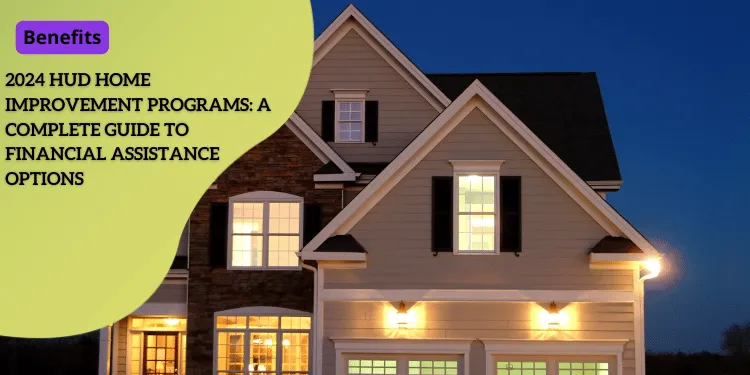2024 HUD Home Improvement Programs: A Complete Guide to Financial Assistance Options

Anúncios
HUD’s Role in Supporting Homeowners
The Department of Housing and Urban Development (HUD) is a lifeline for homeowners needing financial support for repairs and improvements.
HUD’s programs help maintain safe, livable homes by offering loans and assistance specifically designed to address various home improvement needs.
Anúncios
These initiatives focus on everything from essential repairs to energy-efficient upgrades, benefiting a wide array of homeowners.
Beware of ‘Free Money’ Scams
It’s crucial to be vigilant against scams that promise “free money” for home repairs.
Anúncios
The federal government does not distribute free funds for home improvement purposes.
Scammers often exploit homeowners with misleading advertisements, pretending to offer financial aid which doesn’t exist.
To stay safe, only rely on verified government resources and HUD-supported programs.
Types of Assistance Programs Available Through HUD
HUD offers several types of assistance to support home improvement needs:
- Title 1 Property Improvement Loan Program: This program helps homeowners finance repairs, enhancements, and improvements. It provides flexible loan amounts and repayment terms suited to various needs.
- 203(k) Rehabilitation Mortgage Insurance Program: This program allows homeowners to include repair costs in their mortgage, offering up to $35,000 for eligible repairs and improvements.
- Home Equity Conversion Mortgages (HECM) for Seniors: Designed for homeowners aged 62 and older, HECM allows seniors to convert part of their home equity into cash, providing funds for home maintenance and living expenses without monthly payments.
By understanding HUD’s offerings and being cautious of scams, homeowners can effectively navigate the available support and make informed decisions in improving their homes.
In the next section, we’ll delve into the details of the Title 1 Property Improvement Loan Program.
Title 1 Property Improvement Loan Program
Purpose and Scope
The Title 1 Property Improvement Loan Program is a key initiative by HUD designed to help homeowners finance essential home repairs and improvements.
Unlike “free money” scams, these loans require repayment, but they are a great option for those looking to enhance their property’s livability, safety, and overall value.
Types of Improvements Covered
Title 1 loans can be used for a wide array of home improvements, which may include:
- Structural alterations and reconstructions
- Modernization and energy efficiency upgrades
- Upgrades to sewage and plumbing systems
- Adding accessibility features for disabled individuals
Whether your focus is on interior or exterior improvements, Title 1 loans are flexible enough to cover a range of projects.
Loan Amounts and Eligibility
The loan amounts under this program vary depending on the type of property:
- Single-family homes: Up to $25,000
- Multi-family properties: Up to $12,000 per unit, not exceeding a total of $60,000
Eligible properties include single-family homes, multi-family dwellings with up to four units, and even non-residential structures that are primarily residential.
Repayment Terms
Repayment terms are quite flexible, usually ranging from 6 months to 20 years, which allows for manageable financial planning.
Interest rates are generally competitive, making these loans accessible to a broad spectrum of homeowners.
Understanding these terms and options is crucial for maximizing home improvement opportunities while ensuring financial sustainability.
Next, we’ll delve into another significant HUD program that facilitates more extensive home rehabilitation efforts.
203(k) Rehabilitation Mortgage Insurance Program
The 203(k) Rehabilitation Mortgage Insurance Program is a unique HUD initiative designed to help homeowners and potential buyers finance both the purchase of a home and the cost of its rehabilitation through a single mortgage.
This program offers a flexible $35,000 financing option to fund necessary repairs and improvements.
$35,000 Financing Option for Repairs and Improvements
Through the 203(k) program, you can receive up to $35,000 to cover crucial home repairs or improvements.
These funds are not obtained through a separate loan but are incorporated into your existing mortgage, whether it’s a new purchase mortgage or a refinance of your current one.
This allows you to make significant home upgrades without the need for extra funding sources.
Process of Incorporating Funds into Your Mortgage
To incorporate the 203(k) rehabilitation funds into your mortgage, you need to work with an FHA-approved lender.
Here’s how the process typically unfolds:
- Consultation with a HUD-Approved Consultant: This consultant will help you outline the necessary repairs and confirm that they meet the program’s guidelines.
- Loan Application and Approval: Your FHA-approved lender will assist you in applying for the loan, and once approved, the rehabilitation expenses are included in your total mortgage amount.
- Continued Mortgage Payments: The cost of the improvements is added to your mortgage, so you continue making regular mortgage payments just as you would with a standard home loan.
Types of Qualifying Repairs and Improvements Covered
The 203(k) program covers a wide range of repairs and improvements essential for the maintenance and enhancement of your home.
Some qualifying projects include:
- Structural Alterations and Reconstruction: This includes changes to the home’s layout or rebuilding parts of the house that are damaged.
- Modernization and Improvements: Upgrades to improve the home’s overall function, such as adding new plumbing or updating electrical wiring.
- Health and Safety Hazard Elimination: Repairs necessary to remove safety hazards, like fixing faulty wiring or addressing mold issues.
- Appearance Enhancements: Cosmetic upgrades like new flooring, modern kitchens, or updated bathrooms.
- Energy-Efficiency Improvements: Enhancements like installing new windows, improving insulation, or updating heating, ventilation, and air conditioning (HVAC) systems.
By using the 203(k) Rehabilitation Mortgage Insurance Program, you can make meaningful improvements to your home in a financially manageable way.
With this program’s flexibility, you are well-positioned to create a safer, more comfortable living environment without taking on separate loans or excessive debt.
Next, we’ll explore the Home Equity Conversion Mortgages (HECM) for seniors, which provide another specialized assistance option.
Home Equity Conversion Mortgages (HECM) for Seniors
Eligibility Requirements
Home Equity Conversion Mortgages (HECM) are reverse mortgages designed specifically for homeowners aged 62 and older.
To be eligible for a HECM, you must meet the following criteria:
- Be at least 62 years old.
- Own your home outright or have a small mortgage balance.
- Occupy the home as your primary residence.
- Be financially capable of maintaining the property and paying property taxes and insurance.
These requirements ensure that seniors who are able to sustain their living conditions and residence are the ones benefiting from HECM.
Benefits
HECMs offer several advantages for senior homeowners.
Key benefits include:
- No Monthly Payments: Unlike traditional mortgages, HECMs do not require monthly repayments. The loan is repaid when the home is sold or is no longer the primary residence.
- Flexible Fund Disbursement: Funds can be accessed in several ways – as a lump sum, a line of credit, or through monthly payments, offering flexibility to meet various financial needs.
- Government Insurance: HECMs are the only reverse mortgages insured by the federal government, providing an extra layer of safety and assurance.
These benefits can significantly ease financial burdens for seniors, providing them with the necessary funds to maintain and enjoy their homes.
Important Considerations
While HECMs come with numerous benefits, there are important factors to consider:
- Loan Costs: HECMs can be expensive due to fees and interest, which can accumulate over time.
- Decreased Home Equity: As the loan balance increases, your home equity decreases. This can impact the amount your heirs will inherit.
- Counseling Requirement: Before getting a HECM, you must undergo counseling from a HUD-approved agency to ensure you understand the obligations and benefits.
These considerations are crucial for making an informed decision about leveraging a HECM for home maintenance and other expenses.
Understanding these aspects empowers seniors to utilize HECMs effectively while maintaining financial stability and housing security.
Special Programs for Specific Groups
Veterans and Service Members Assistance
Veterans and service members have access to specialized programs for home improvement, particularly through the Department of Veterans Affairs (VA).
The Specially Adapted Housing (SAH) Grant and the Special Housing Adaptation (SHA) Grant help veterans with service-connected disabilities to modify their homes for better accessibility and safety.
These grants cover modifications like widening doorways, installing ramps, and other essential changes to ensure the homes are livable for veterans with mobility needs.
The VA Home Improvement Loan is another valuable resource, providing funds for necessary repairs and enhancements.
This loan complements the VA’s general home loan benefits, making it easier for veterans to maintain their homes in good condition.
Rural Resident Programs
The USDA Rural Development program offers several options to assist rural residents.
The Single Family Housing Repair Loans and Grants, also known as Section 504 Home Repair Program, provide funds to low-income rural homeowners for repairs, improvements, and modernization.
Grants under this program are also available to elderly low-income homeowners to remove health and safety hazards from their homes.
Another valuable program is the Rural Housing Direct Loan Program, which helps rural residents secure affordable housing loans.
By offering these tailored programs, USDA aims to ensure that rural homeowners can maintain and improve their living conditions.
Native American Specific Programs
Native American communities can benefit from specific HUD programs designed to meet their unique needs.
The Indian Home Loan Guarantee Program, also known as Section 184, provides home loans for purchases, construction, and rehabilitation of homes on tribal and non-tribal land.
This program features low down payments and manageable loan terms, increasing homeownership opportunities for Native American families.
Additionally, the Bureau of Indian Affairs (BIA) Housing Improvement Program (HIP) supports critical repairs and renovations for low-income Native American families living in substandard housing.
These initiatives aim to improve home conditions while addressing the specific needs of Native American communities.
By leveraging these tailored programs, diverse groups such as veterans, rural residents, and Native Americans can access the support they need to enhance their living environments effectively.
To further assist homeowners, exploring state and local options offers another avenue for support.
State and Local Assistance Options
How to Find Local Government Programs
Finding local government programs to assist with home improvements can significantly ease financial burdens.
Start by visiting your city’s or state’s official website, and look for the housing or community development section.
Many cities and states offer tailored programs to help with repairs and enhancements.
These departments are usually dedicated to helping residents maintain and improve their homes, making necessary information readily accessible online.
State-Specific Assistance Opportunities
Each state has unique programs catered to its residents:
- In California, the CalHome Program offers grants and loans for home repairs.
- New York has the Home Improvement Program (HIP), which helps eligible homeowners with essential repairs to keep their homes safe and livable.
To find state-specific programs, visit your state’s Department of Housing and Community Development website.
Many local resources provide detailed guidelines on available programs and their eligibility requirements.
Process for Applying Through Local Housing Departments
Applying for local or state assistance typically involves a few straightforward steps:
- Research: Visit your local or state housing department’s website to learn about available programs.
- Eligibility Check: Review the eligibility criteria such as income limits, property type, and specific needs.
- Documentation: Gather necessary documents including proof of income, property ownership, and identification.
- Application Form: Fill out the application form and submit it through the designated process, which could be online, via mail, or in person.
- Follow-Up: Keep in touch with the housing department for any additional requirements or updates on your application status.
By following these steps, you can facilitate a smoother application process.
Understanding the wealth of assistance available through both state and local governments can empower homeowners to maintain and improve their properties effectively.
This nuanced approach ensures homeowners access exactly what they need, tailored to their specific circumstances.
Eligibility Requirements and Documentation
Income Level Considerations and Limitations
Eligibility for HUD home improvement programs often hinges on the applicant’s income level, which is designed to favor low to moderate-income households.
Each program sets specific income limits to ensure that assistance goes to those most in need.
Generally, these income thresholds are measured relative to the area median income (AMI), enabling fair access to funding across different regions.
It’s crucial to check the precise income requirements for the program you’re interested in, as they can differ significantly.
For instance, programs like the Title 1 Property Improvement Loan and the 203(k) Rehabilitation Mortgage Insurance typically target lower to middle-income brackets.
Property Type and Location Requirements
The type and location of your property can also influence eligibility for HUD programs.
Different initiatives have varied criteria focusing on specific property types. Some programs may exclusively cater to single-family homes, while others can include multi-family dwellings, non-residential buildings, or manufactured homes.
Location is equally critical, with certain programs directed at rural areas, such as those offered by USDA’s Rural Development, while others may prioritize urban settings or particular geographical regions.
Understanding these nuances ensures you apply for the program that best fits your property’s characteristics.
Required Documentation and Application Materials
Preparing the necessary documentation is essential to securing HUD home improvement assistance.
Typically, you will need:
- Proof of income (e.g., pay stubs, tax returns)
- Property ownership documents (e.g., title, deed)
- Identification (e.g., driver’s license, passport)
- Detailed estimates or plans for improvements
- Loan application forms
Gathering these materials ahead of time can streamline the application process, making it smoother and less stressful.
Be sure to follow the specific instructions from the program you’re applying for, as requirements might slightly differ.
By understanding your eligibility and having the right documentation, you can make the application process more efficient.
This knowledge not only aids in securing funding but also helps ensure that homeowners can improve their properties safely and effectively.






